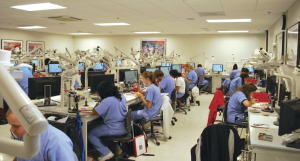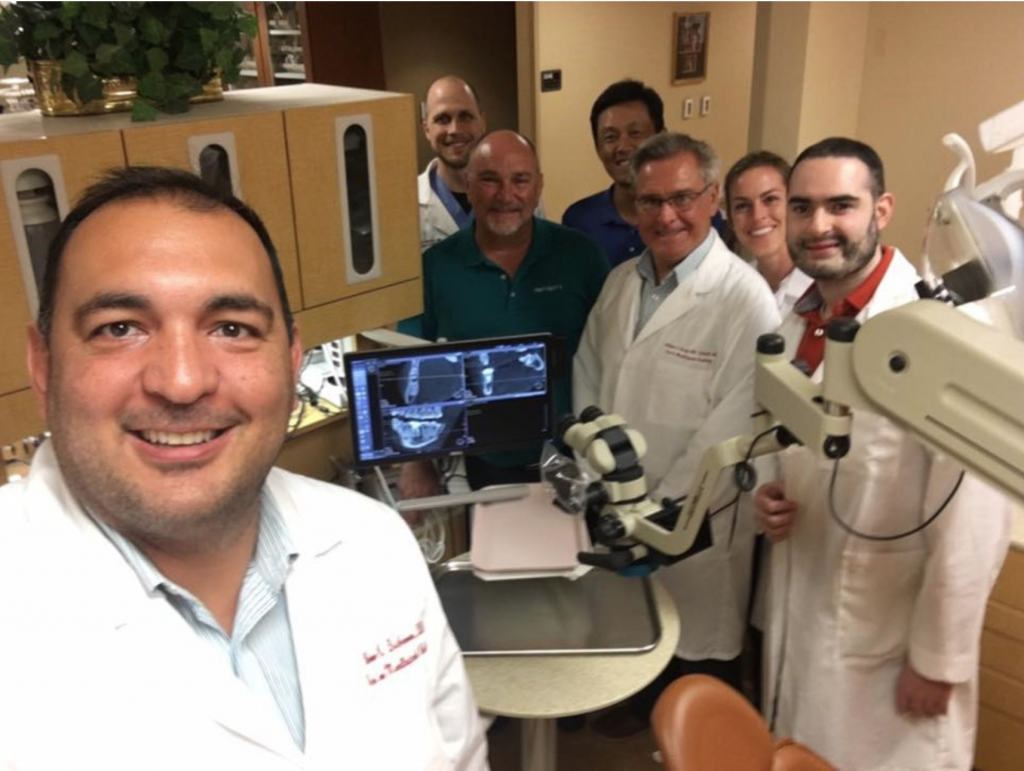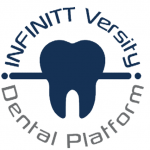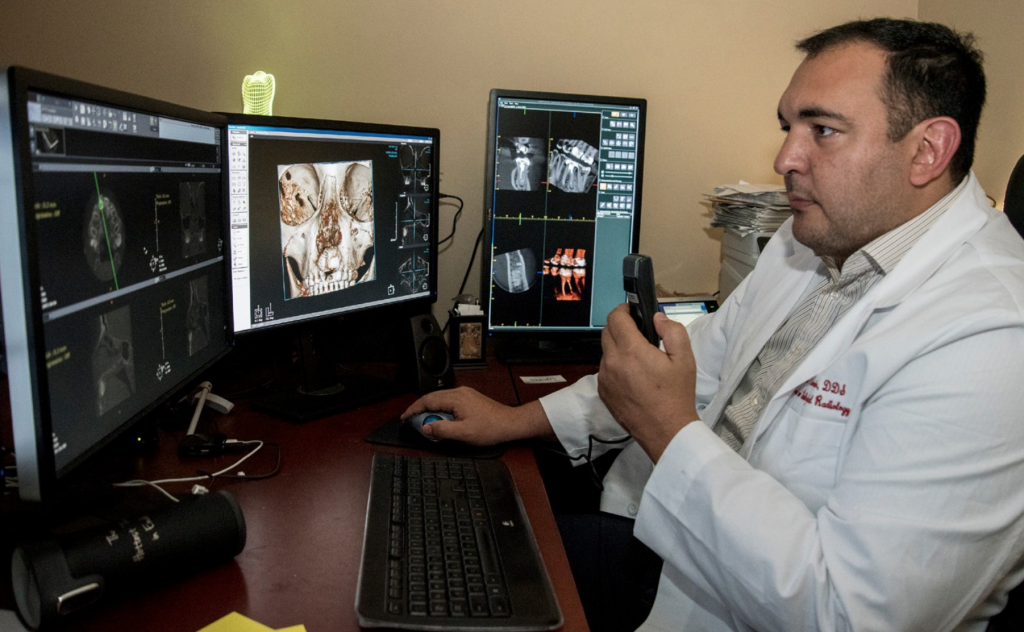The University of Louisville School of Dentistry (ULSD) is one of the nation’s premier dental institutions. With over 600 students enrolled across the full spectrum of dental specialties, ULSD serves the dental health needs of the citizens of the Commonwealth of Kentucky by engaging in sponsored research and by educating and training competent health care professionals. In addition to the primary facility in Louisville, patient services are delivered at the University of Louisville Hospital as well as two satellite clinics. These facilities generate 100 extra oral imaging studies per day or 30,000 annually.
ULSD was looking for an imaging technology platform to meet the needs of their complex setting.
Their requirements were:
- A highly efficient digital workflow allowing the institution’s three oral and maxillofacial radiologists to obtain 3-D images quickly, interpret them, distribute findings, and store in a fully structured format.
- Support for instruction in the latest 3-D imaging and treatment techniques.
- Flexibility for future growth.
Primary Imaging Challenges
ULSD faced significant obstacles in meeting these needs and fulfilling its mission. Specifically, three top “pain points” were identified.
1. Sub-Optimal Mixed Technology Environment
ULSD, like many dental schools, has grown its use of Dental Cone-beam Computed Tomography (CBCT) imaging and now utilizes seven systems from multiple vendors. Each possesses proprietary software with limited integration flexibility. As Dr. William C. Scarfe, professor and director, RIS in the Surgical and Hospital Dentistry Department, observed, “Until recently, we were in the same place that diagnostic medical radiology was 20 years ago, supporting multiple proprietary formats with limited inter-operability.”
In addition to being inefficient for the clinical environment, this hybrid situation was also detrimental to education.
Noting that dentists are rapidly purchasing in-office CBCT scanners but are frequently not trained in the essential interpretive skills 3-D imaging demands, Dr. Scarfe explained, “The only way to achieve such competency is to develop confidence by examining many images.” At most dental schools, students complete a one-day rotation through digital radiology, but ULSD believes far deeper exposure is required.
Dr. Bruno Azevedo, assistant professor in RIS, stated the university wants its graduates “to be among the few who are trained to read these images in specific cases, which will translate to improved diagnoses, customized treatment plans and better clinical outcomes.” Unfortunately, the disparate CBCT software hindered the ability to optimize student time.
2. Difficulty Storing Images
Dr. Scarfe noted that many contemporary dental image files, including DICOM CBCT images, are volumetric. These include a variety of non- DICOM formats such as sterolithography files (STL) CAD files (OBG), and others. Moreover, data sharing, electronic health records, and academic research require detailed metadata associated with the image.
3. PACS Systems Inadequate to the Task
Most PACS systems on the market are designed for diagnostic medical radiology, lacking modules specific to dental imaging and incapable of storing large non-DICOM formats, particularly suitable in an academic setting.
Search for the Solution
 To overcome these problems, ULSD set about finding the right Dental PACS, an evaluation process that involved several steps.
To overcome these problems, ULSD set about finding the right Dental PACS, an evaluation process that involved several steps.
First, the leadership team established a set of core requirements. The desired system needed to:
- Be designed for dental imaging.
- Have robust, centralized storage capabilities with support for non-DICOM files.
- Retrieve images for users rapidly. The previous system was taking a productivity-draining 5 to 10 minutes for 3D volume download.
- Function in a Citrix environment. As Christopher Morgan, director of Dental Informatics, explained, “We actively use about 675 thin clients as well as 300-400 full workstations. That footprint makes retrieval and distribution even more challenging.”
- Integrate well with the dental patient management system. Added Morgan, “Like many academic institutions, we use axiUm as our dental practice management system. So, that bidirectional integration was essential as well.”
- Centralize image management. Dr. Scarfe noted that “the radiology department reads every scan throughout the enterprise, and we wanted the system to reside in the department.”
- Distribution likewise needed enhancement. “We were inefficient, saving and emailing .jpg, .pdf, and other files with no structured information,” noted Scarfe.
- Integration with multiple CBCT systems. In an ever-changing academic environment, it is very important to be able to work and integrate multiple different pieces of imaging hardware into one unique environment.
The next step was to consider the new technology’s role in the institution’s long-run strategy. ULSD has committed to technological leadership via recent initiatives such as fully outfitted 3-D Virtual Print and Digital Dentistry labs. An agile Dental PACS partner with strong development skills was vital to the strategy.
Finally, the team investigated several systems, both traditional PACS and those claiming a dental focus. In the case of INFINITT this process included site visits to existing users such as Temple University in Philadelphia, Pennsylvania. INFINITT’s dental customers include Case Western University, University of Connecticut and several other major schools as well as large, multi-facility dental clinics.

INFINITT Dental Platform: The Right Move
 ULSD’s due diligence determined that most systems were simply unable to meet the team’s essential requirements.
ULSD’s due diligence determined that most systems were simply unable to meet the team’s essential requirements.
They had difficulty managing the 3-D environment and lacked centralized storage to unify the distributed CBCT problem. Retrieval latencies and feature gaps such as minimal reporting tools were also prevalent.
INFINITT emerged as the clear choice. The company’s Versity Dental Platform consolidates in one modular system PACS, VNA, dental applications, and data management. It provides integration with – and a singular user experience across – all major devices such as CBCT, with full non-DICOM file handling as well as centralized storage. The ULSD team felt that this combination of extensive core radiology PACS functionality, robust
3-D management, and specific dental imaging software was the best fit.
“INFINITT provides two important tools for the educational mission. First, job saving to the patient’s file for all work- in-progress to retain sequential changes – which was not available in our existing systems. Second, a customizable faculty approval process and tracking for all student review.” Dr. Bruno Azevedo Oral and Maxillofacial Radiologist
Additional aspects of INFINITT tipped the scales:
- Track record of integration including an interface permitting single- click access to studies from axiUm and compatibility to voice recognition software (Dragon Medical) which, together with a customized report template, allows for fast reporting on imaging
- A worklist Dr. Scarfe explained, “Managing all studies for ULSD through a three-person radiology department absolutely demands a worklist. Most systems simply present each case sequentially. INFINITT has a detailed worklist enabling each radiologist extensive control over processing cases.”
- Critical teaching features ULSD adopted INFINITT’s Xelis Dental advanced 3-D reconstruction software which offers precise measurements and anatomical information on all oral and maxillofacial structures with a host of treatment planning tools. Dr. Azevedo described the importance: “Students need to update and alter plans based on new work and faculty input. In addition to the strong 3-D visualization and analytical features in Xelis, INFINITT provides two important tools for the educational mission. First, job saving to the patient’s file for all work-in-progress to retain sequential changes – which was not available in our existing systems. Second, a customizable faculty approval process and tracking for all student review.”
- Metadata. INFINITT’s Uploader software provides special handling for STL files with ability to attach desired patient metadata for subsequent accurate file sharing, analytics, and other purposes.

Implementation Lessons and Recommendations
ULSD chose to roll out the INFINITT system progressively, first piloting with endodontics residents and then following a priority plan that included oral/maxillofacial surgery, the satellite clinics, and on to the rest of the departments. “We took our time and have worked in stages,” explained Dental Informatics Director Christopher Morgan, “That approach promotes adoption while allowing IT to adjust implementation and tweak the software as needed.” Morgan cited the thin client situation as an example, where adjustments proved necessary to accommodate different browsers.
Integrations presented one of the largest IT challenges. “We entered uncharted territory to some degree,” said Morgan. Each CBCT unit was from a different manufacturer and presented a different integration challenge. That variability made project management especially difficult. Morgan observed that “the integration support from INFINITT was very good; they built the bridges we needed to all systems and axiUm electronic health record.”
INFINITT also assisted with user interfaces. While customers can adopt the Xelis front-end, Louisville chose to customize. Dr. Azevedo remarked, “INFINITT offers considerable flexibility to arrange icons and layout. Their engineers were very helpful in guiding us on best designs as well as a training template.”
Dr. Scarfe added broader advice for those embarking on a new system. “Support from the administration is crucial – not just buy-in but also establishing and committing to a real technology vision. This is not a one-time purchase.”
Benefits Achieved
The results from adopting INFINITT have proven significant. ULSD has realized time and process efficiencies from centralized file handling, download speed, and strong worklist control. Further productivity and quality gains have emerged from use of INFINITT’s reporting tools, particularly the ability to merge images and text in one document that greatly enhances communication of findings.
Equally important, the school’s educational goals are being met. Providing one access point to the CBCT machines, better treatment planning software, and tools that facilitate the student-faculty workflow, INFINITT’s dental PACS is optimizing learning. Dr. Scarfe succinctly summarizes the impact: “INFINITT is helping us produce the next generation of digital-savvy dentists.”
Future Directions
The school anticipates expanded use of the INFINITT Versity Dental Platform’s modules and is examining taking advantage of productivity-enhancing reporting tools such as dictation/speech recognition and integration of output from multimedia sources such as dental cameras.
For dental schools, the evidence is clear: INFINITT offers the systems that meet today’s urgent 3D imaging educational and clinical needs … and tomorrow’s.